
EV Pusher Trailer

Recent
Trips:
Palo
Alto, CA to Sacramento, CA and back (300 miles in one
day)
![]()
Top Speed: ~80 mph (flat ground, gasoline only)
Top Speed: >100 mph with electric and gasoline
use
Cruise Speed: 65-70 mph
Engine: 1800 cc Volkswagen Rabbit stock,
water-cooled, fuel-injected, gasoline engine
(1981)
Transmission: '81 Rabbit stock automatic
Efficiency: 30 mpg (EV with trailer net at 65+
mph)
Range: >300 miles (13 gallon capacity)
Emissions: Catalytic converter, and fuel vapor
recovery system
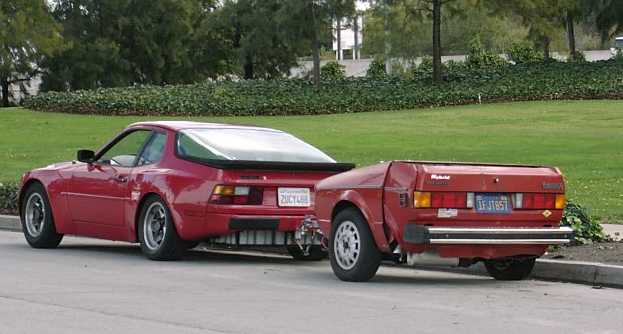
Why?
As anyone involved with EV's knows RANGE
is the one central problem (combined with
slow re-charge times.) EV's will have
ranges between 25-110 miles (home-built to
optimized production.) Recharge times can
be as low as 1-3 hours with high capacity
chargers. These range/charge times still
do not allow long-distance freeway travel
on the occasions when it is needed.
The idea of the pusher trailer and/or
generator trailer is to give the normal EV
long-range capability with fast fuel stops
without permanently installing an IC
hybrid system in the vehicle. This saves
the weight, and mess, of having the IC
engine with you (in the EV) for the 80+%
of driving that is done within the EV's
normal range. For long-range operation,
the IC engine will take over all of the
load and battery drain will cease or
slowly reverse.
Generator vs. Pusher (Series vs. Parallel hybrid)
The "normal" approach to hybrid
trailers (if there is one) is to
have an IC engine driving a
generator that sends electricity
forward to the EV to supply the
energy needed for highway
cruising.
Click to
See ---> AC
Propulsion's hybrid
generator trailer
Generator benefits:
* Energy can be stored in the
batteries when IC output is
greater than needed.
* The IC load is very level as
the generator output can be
nearly constant.
* No transmission is needed
* Standard trailer dynamics
apply
However, this approach suffers
from the inherent problem that
the energy is transformed from
mechanical (at the IC shaft)
into electrical, and then back
to mechanical (at the EV
motor.) The energy will in the
best case go through the
generator, EV motor
controller, and EV motor. In
the worst case it will also
cycle in and out of the
batteries. All of these
conversions deal a serious
blow to the best efficiency
possible. For a typical EV
system you will need between
1/2 and 2/3 of the IC
horsepower to simply push the
car as you will to generate
enough electricity to drive
it.
Pusher Benefits:
* Fewer energy conversions
Chemical--->Thermal--->Mechanical
* Less IC horsepower needed
* Potentially lighter than a
gen. trailer (smaller
generator, less fuel, less IC
hp)
* EV system does not need to
be sized for continuous use
* Cheaper (no generator, more
standard automotive parts)
The hybrid trailer in general
only makes sense for long
distance freeway travel
(roughly greater than 50
miles.) The trailer efficiency
will fall at slower speeds
since the IC output must be
cycled through the batteries
or throttled back in the case
of the pusher. In addition,
urban driving raises the
obvious problem of parking
with the trailer in congested
areas.
More Pictures:
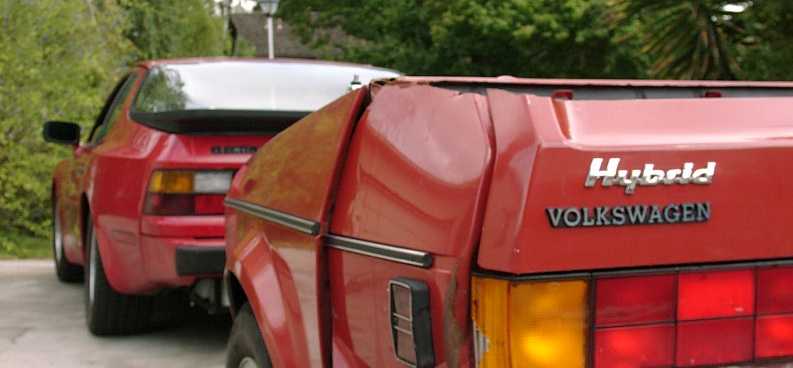


Trailer connection to the EV, two simple plugs and a standard ball

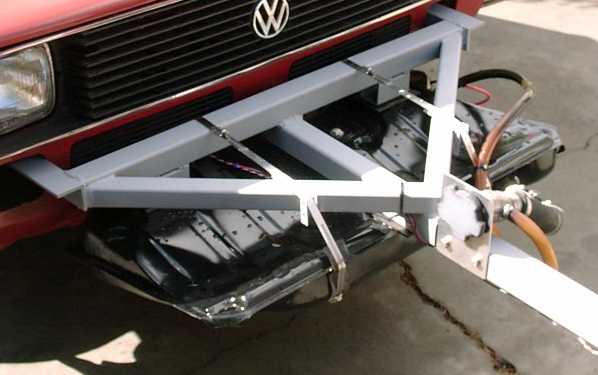
Fuel tank and trailer structure
Control: One
difficult problem
with the pusher
trailer is how to
control the throttle
and transmission
remotely. I have
chosen to keep all
control electrical
so that there is
only a simple
electrical connector
to the EV (see
photo.) With the
second generation
trailer, the
automatic
transmission takes
care of shifting.
The lights are
linked to the EV's
(brake, running,
turn.) The throttle
is controlled by a
large hobby RC-type
servo motor. There
is a
micro-controller on
the trailer that
takes an input
signal from a 5k
potentiometer in the
EV and then sends
the proper command
to the throttle
servo (see servo
picture.)
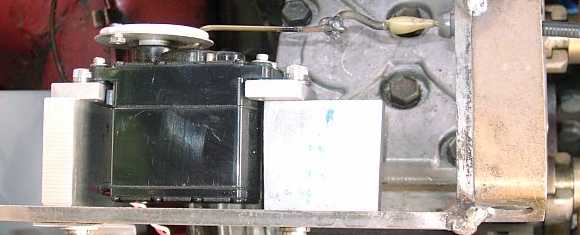
Operation:
This second
generation
hybrid trailer
is very easy to
"drive." All of
the controls
have been
integrated into
the dashboard of
the EV so there
are no dangling
wires, etc.
Since the
trailer has an
automatic
transmission, it
is left in the
"drive" position
always. The
interlock that
normally
prevents
starting the
engine in drive
has been
removed. When
towing the
trailer without
the engine on,
the automatic
transmission
(AT) clutch is
disengaged and
the IC engine
does not spin.
So the wheels
turn freely
(with only a
slight extra
drag from the
AT.) Towing the
trailer for long
distances with
the engine off
is "not advised"
since the AT
does not have
proper
lubrication. But
long distances
are defined as
10-30 miles in
the service
manual (in
between engine
starts.) And,
since the EV
probably can't
even tow the
trailer 30 miles
in between
charges...this
isn't a large
concern. It just
isn't possible
(and doesn't
make sense) to
tow the trailer
"long distances"
without turning
it on.
In the EV there
is an ignition
on/off switch
and an engine
start button
(see picture
below.) There is
also a small, 5k
potentiometer
that controls
the throttle on
the engine. This
could be wired
directly into
the 5k pot that
is on the gas
pedal running to
the EV
controller, but
I opted for
totally separate
controls during
initial testing.
Driving the
EV/trailer
combination is a
piece of cake.
The AT shifts as
needed and you
simply control
the desired
throttle level.
It's also fun to
simply turn the
engine off when
the traffic
slows down or
stops in rush
hour and creep
along silently
with the
electric drive.
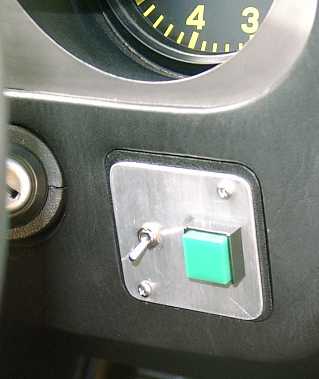 ------
------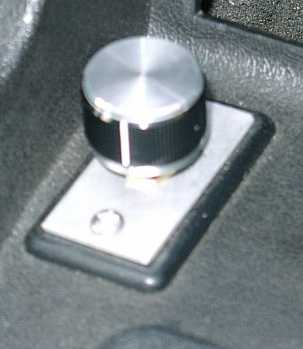
Dynamics: Despite the facts that I shortened the trailer of the
Gen-2 pusher
by two feet
and added more
IC horsepower
and much more
pushing force
with the
ability of the
AT to
downshift...I
have still
found it
basically
impossible to
get into a
condition of
over-steer.
(This is where
the car would
want to turn
into the
direction of
the turn if
you take your
hand off the
wheel,
normally if
you release
the wheel a
vehicle will
straighten
itself out of
a turn) Even
in relatively
tight turns
with the
trailer at
nearly full
power, the car
wants to
straighten
itself out.
The shortened
trailer also
drafts behind
the EV much
better further
improving the
mpg.
Things to add...
* IC
engine cruise
control (built
in throttle
actuator)
* Auxiliary
high-voltage
alternator on
the IC
(1000-2000
watts) to keep
batteries
charged
(And to allow
for greater
electric use
during hill
climbing and
hard
acceleration)
The hybrid
trailer makes
it completely
possible to
get by without
a dedicated IC
car at all.
This allows
the normal EV
to meet 100%
of your
driving needs
without
sacrificing
zero-emission
city driving
and grid
recharge-ability
(as all
production
hybrids today
do.)
Site Last Updated On: Oct/26/2000
(archive clone from deleted jstaubel.com
page -
modified by
brucedp)
- Home
-